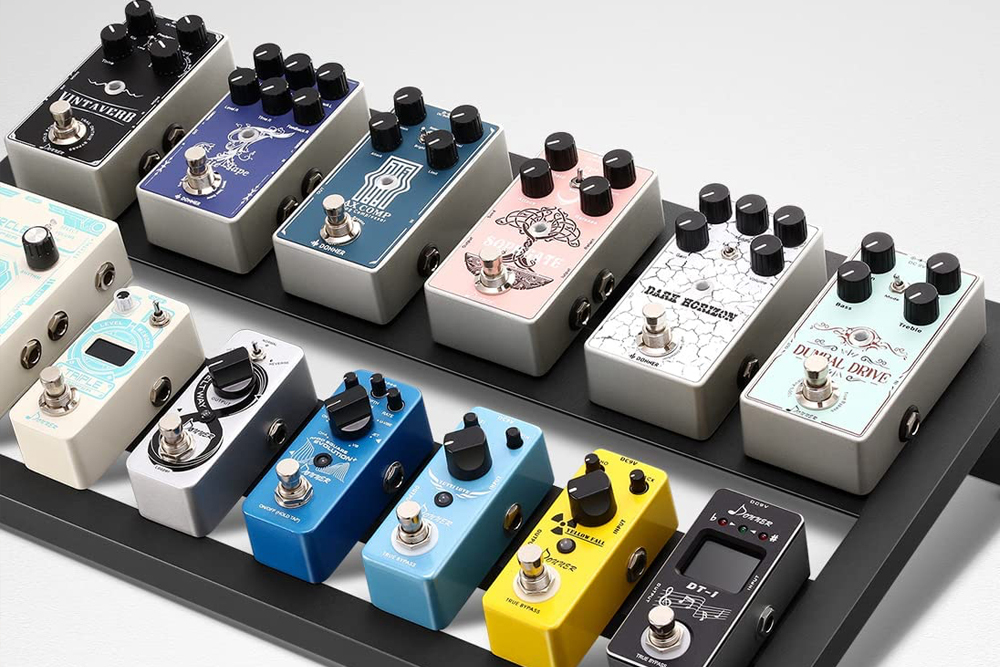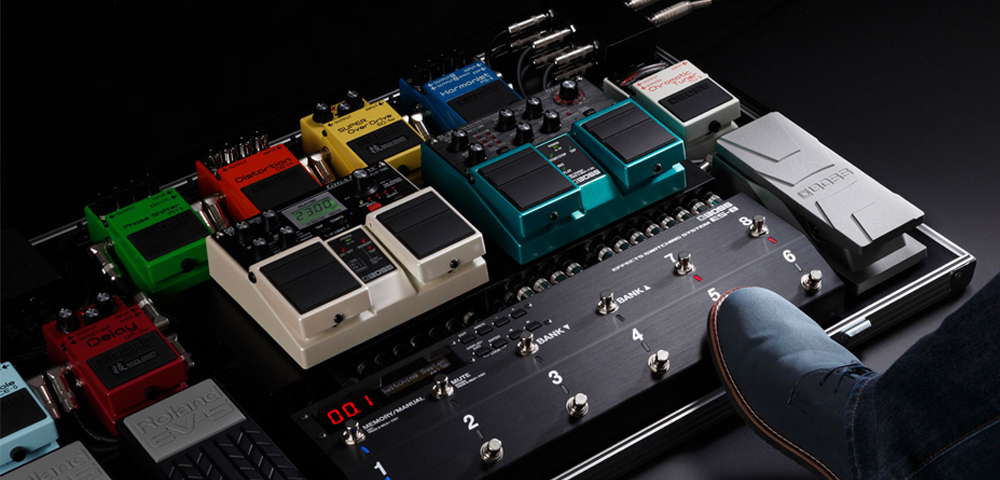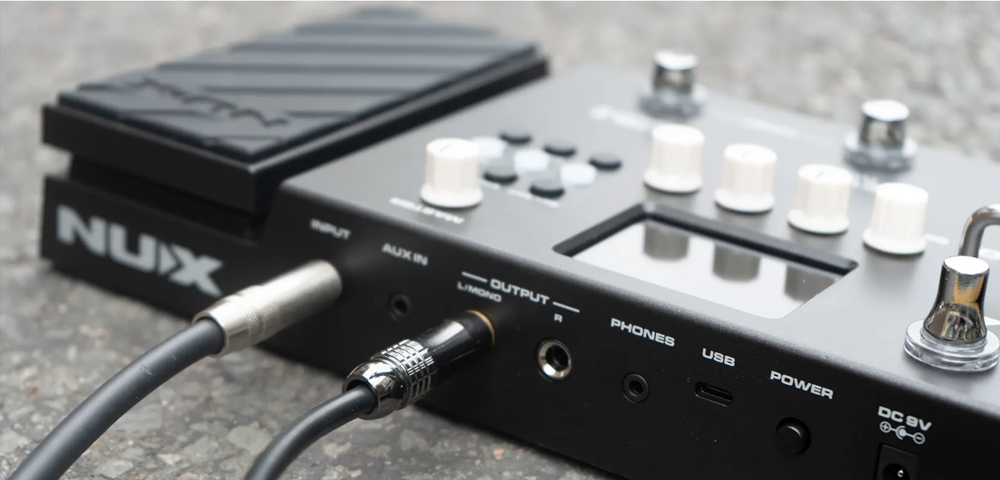
Effects pedals are an essential part of any electric guitar player. Playing the electric guitar without any effects pedal is like cooking without salt and pepper. You can definitely do without the pedals, but you’ll just be stuck with very limited tones to play.
So today I’ll be running you through what effects pedals are and what they do. As well as what are some of the effects pedals you may need, and how you go about choosing them.
What Do Guitar Effects Pedals Do
Another way of asking this question is do you need an effects pedal? And the answer is yes. The sole purpose of an effects pedal is to produce a certain tone (sound) which cannot be achieved otherwise without an effects pedal.
Most amplifiers do come with built-in effects such as overdrive or reverb, but these built-in effect options are often limited in variety. So in order to produce the type of tones you want in your playing, you’ll need to experiment and invest in an effects pedal that suits your style.

How Do Guitar Effects Pedals Work
A guitar effects pedal works by converting the signals it receives from your electric guitar, applying the effects of that particular pedal, and then delivering the sound out via the amplifier.
So in a simple illustration, you’ll hook your electric guitar up to, for example, a distortion effects pedal, at the same time the effects pedal will be hooked up to the amplifier. By stepping onto your pedal once, with each step you can activate the ‘distortion’ effect on or off.
When the effect is on, anything you play on your electric guitar will come out of the amplifier sounding distorted. When the effect is off, the sound will return to the original sound of your electric guitar.
With more advanced players, effects pedal can also be connected with each other in a series of orders (stacked) to produce a unique tone of the players’ style.
Types of Guitar Effects Pedals
Effects pedals can be categorized into a few group types. The most recognizable effects are probably from the ‘Filter’ group, which includes effects such as the ‘Wah-Wah’ effect that can be easily spotted in many of Jimi Hendrix’s music.
The 8 Best Wah Guitar Moments Ever
There’s also the ‘Talkbox’ effect, used in a lot of Guns ‘n’ Roses’ music, as well as in the intro of the popular rock song ‘It’s My Life’ by Bon Jovi.
Bon Jovi – It's My Life (Guitar Cover HQ with TalkBox)
‘Filter’ works more or less like an EQ on a stereo, changing the tones by means of altering the frequencies, and resulting in unique sounds with different highs and lows.
Another common effect that you’ve often heard in rock music is the ‘Distortion’ effect, part of the ‘Gain’ group. ‘Gain’ works by altering the saturation of audio signals (volume input against output) in order to change the characteristics of the sound.
Overdrive, Distortion, Fuzz: What's the Difference? Marty Music Gear Thursday
The ‘Overdrive’, ‘Boost’ and “Fuzz’ effects are also from the ‘Gain’ group.
Some other effects groups include:
‘Utility’, with pedals used more for controlling volume and tuning;
‘Time’ , effects from this group, like the name, alter time-related effects such as the ‘Delay’ and ‘Reverb’ effects;
‘Modulation’, with effects such as ‘Echo’, ‘Chorus’, ‘Vibrato’, ‘Tremolo’, and ‘Flanger’ etc.
For more details about some of the most common effects pedal mentioned above, please check out this article right here: "Introduction to Basic Guitar Effects".
What Guitar Effects Pedals Should a Beginner Buy
As a beginner, you’re most likely not experienced enough to know what kind of effects is suited for you. The best you can do is to follow what some of your favourite artists are using, and from there learn what are the common effects used in the different genres of music.
A basic effects pedal setup would typically include effects such as ‘Overdrive’, ‘Distortion’ or ‘Fuzz’, ‘Reverb’, and ‘Delay’.
‘Overdrive’ and ‘Distortion’ are considered integral to most (if not all) rock and metal music. The ‘Fuzz’ effect is somewhere in between ‘Distortion’ and ‘Overdrive’, with the ‘Overdrive’, commonly used in Blues, being the mildest of the three.
If you’re into grunge or classic rock, then the ‘Fuzz’ effect would be a better fit than the ‘Distortion’ effect.
The ‘Reverb’ effect has a more natural sound and is commonly used in Jazz. As for the ‘Delay’ effect, it is often used to add more space and ambient to your music.
These effects are also common to most rock music setups. And as mentioned, you can also combine a few of the effects in the list and use them for other genres of music, such as Pop, Jazz and Blues.
The one drawback of buying these effects pedals is they can get quite expensive. Hence, the alternative to getting these effects pedals individually is, you can consider buying something called the Multi-effects processor (modeler).

Multi-effects processors are very popular these days due to their convenience in portability, as well as having several effects and adjustable functions all on just one pad. And in most cases, multi-effects processors are cheaper than buying 5 separate effects pedals.
For example, NUX MG-400, the latest effects modeler from NUX is both portable in size and a value for your money. An effects modeler like this offers:
- Sounds produced by 25 different types of amplifiers, 1 bass amp, and 1 acoustic amp;
- Multiple microphone options and positioning settings to mimic the difference in sound reception;
- Ability to arrange the order of the different effects in priority to one another;
- Easy recording and looping functions;
For your first-time experience with effects pedal, a modeler such as the NUX MG-400 can be a very user-friendly introduction, without having to break your wallet.
In my opinion, buying a multi-effects processor is like going to a buffet and trying out the different types of cuisines for one price. Buying individual effects pedal, will be you understanding what you want and going for a specific taste of a specific cuisine group.
Can Pedals Be Used With Acoustic Guitars
It is not so much about whether can you use electric guitar effects pedals on an acoustic guitar. It’s more about which effects will sound good on an acoustic guitar.
Do Electric Guitar Pedals Work on Acoustic Guitar?
Generally speaking, most effects from the ‘Utility’, ‘Time’, and ‘Modulation’ groups may well work on an acoustic guitar. But most effects from the ‘Gain’ effects group like ‘Overdrive’ or ‘Distortion’, which are more electric guitar-specific type effects, may just sound weird or simply just out of place on an acoustic guitar.
So, you can definitely use effects pedals with an acoustic guitar, it’s just a matter of what effects you’re using to produce the sound and tone you want.
In conclusion, if you’re starting on becoming an electric guitar player, then effects pedals are definitely something you’ll need to look into if you want to produce a wide variety and tones and sound possibilities.
Rock On lnnl,
Related resources:
A Beginner's Guide To Guitar Effects Pedals…Effect Types Explained!
NUX MG- 400 Multi-effects Processor (Modeler)



